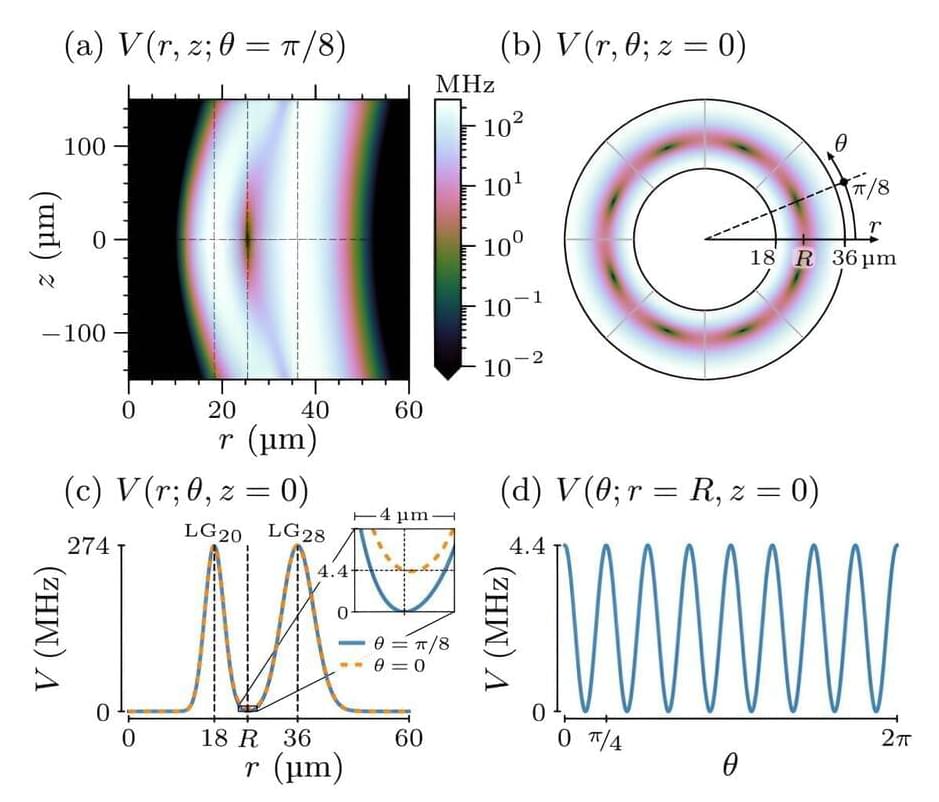The state could be used for exquisitely sensitive measurements and even to test the Standard Model.



Most of the current atom interferometers are large instruments, occupying buildings and requiring towers that can reach tens of meters in height. Now, University of Michigan physicists have developed a design for a quantum rotation sensor with a core size that is barely visible to the human eye.
The proof-of-concept design could help bring atom interferometer-based quantum sensors out of the laboratory and into the world, according to lead author and U-M doctoral student Bineet Dash.
Scientists could use atom interferometers in quests ranging from the continual hunt for the tiny ripples in the fabric of our universe caused by gravitational waves to understanding minute, localized changes in Earth’s gravity caused by melting ice sheets in Antarctica, Dash says. But because of their size, atom interferometers are typically bound to laboratory settings. Currently, the most sensitive atom interferometers use tall towers inside buildings to shoot beams of atoms across tens of meters to gather information.

Researchers explore an intriguing phenomenon in quantum systems, drawing inspiration from a recent quantum computing experiment.
Earlier this year, researchers at the Flatiron Institute’s Center for Computational Quantum Physics (CCQ) announced that they had successfully used a classical computer and sophisticated mathematical models to thoroughly outperform a quantum computer on a task that some thought only quantum computers could solve.

https://lnkd.in/gPGP3Q3j In this article, we propose a new Feynman’s path integral approach and extend this formalism into curved spacetime and consider its possible implications for black hole physics. While still a work in progress, this model suggests that black holes, rather than representing the final stages of gravitational collapse, might contribute to the formation of new universes. We carefully examine both Schwarzschild and Kerr metric of rotating and non-rotating black holes. We derived that rotating black hole will create a traversable worm hole without exotic particles and non-rotating back hole will create another universe by interpretation of path integral finally. We proposed the way how to create the wormhole between two interstellar space using qubits. This proved ER=EPR. John Preskill Dear Professor Preskill Please help me check it Sir.


A new photonic processor efficiently solves complex NP-complete problems using light, offering faster computation and scalability for future applications in optical neural networks and quantum computing.
As technology continues to evolve, the limitations of traditional electronic computers are becoming more evident, particularly when addressing highly complex computational problems. NP-complete problems, which grow exponentially in difficulty as their size increases, are among the most challenging in computer science. These issues affect a wide range of fields, from biomedicine to transportation and manufacturing. To find more efficient solutions, researchers are turning to alternative computing methods, with optical computing showing significant promise.
Breakthrough in Photonic Processor Development.
Here’s Malur Narayan of Latimer AI sharing about removing bias, and setting a standard for identifying and measuring it in artificial intelligence systems, and LLM’s.
Malur is a tech leader in AI / ML, mobile, quantum, and is an advocate of tech for good, and responsible AI.
Meet the rising stars,…
Malur Narayan is a tech leader in AI/ML, Mobile, Quantum and Tech for Good. He focuses on three different principals: Equity, Sustainability, and Mental Health. Malur is a board member, eternal optimist and a forever student.
Connect with Malur on LinkedIn: / malur.
Quantum, Blockchain & AI | Sarah Baldeo, Founder, ID Quotient Advisory Group. Sarah will be presenting at the upcoming Fin+AI 2024 Conference.
Register with code EARLYBIRD until July 15th — www.finaiconference.com.
Sarah Baldeo is an experienced neuroscientist, technologist, corporate strategist and entrepreneur, closing on 20 years of leadership experience. Sarah shares her experience in working with banks, payment providers, insurance, and other enterprise organizations. Sarah shares her perspective on AI, Quantum, Blockchain and other technologies.
In 2023 Sarah graced more than 50 stages, and gave 24 keynotes, was featured on 960AM radio, and most recently nominated for the DMZ 2024 Women of the Year Award & the Top 25 Women of Influence Award. You may have even seen her on TV during the Wimbledon Open Commercials!
Sarah On LinkedIn:


A recent breakthrough in frequency conversion has achieved substantial bandwidth, opening new possibilities for more efficient quantum information transfer and advanced integrated photonic systems.
Advancements in quantum information technology are enabling faster and more efficient data transfer. A major challenge, however, lies in transferring qubits—the fundamental units of quantum information—across different wavelengths while preserving their crucial properties, such as coherence and entanglement.
As reported in Advanced Photonics, researchers from Shanghai Jiao Tong University (SJTU) recently made significant strides in this area by developing a novel method for broadband frequency conversion, a crucial step for future quantum networks.